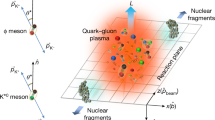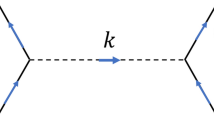Abstract
IT is well known that the vector theory of the meson1 contains a fundamental length in the interaction of mesons with protons and neutrons determined by the fact that the mass of the meson appears explicitly in the denominator of some of the interaction terms. This circumstance has the result that in those elementary processes in which the momentum change is large compared with mc, m being the mass of the meson, the interaction becomes very large, leading to Heisenberg explosions, and to greater divergences in some second-order effects than is the case in radiation theory. This has led Heitler2 and others to the view that the meson theory in its present form is quite incorrect for meson energies larger than about mc2, and Heisenberg3 to the position that quantum mechanics is competent to deal accurately with only those elementary processes in which the condition4 due to Wataghin, is satisfied, E and p being the initial and final energy and momenta of a particle concerned in the process, and ro a fundamental length of the order mc. The purpose of this note is to bring forward an argument which, it seems to me, shows first that the limitation of quantum mechanics by the condition (1), if true, cannot be based on the explosions as derivable from the theory of the meson, and secondly, to throw some doubt on (1) itself as a limit to the correctness of quantum mechanics.
This is a preview of subscription content, access via your institution
Access options
Subscribe to this journal
Receive 51 print issues and online access
$199.00 per year
only $3.90 per issue
Buy this article
- Purchase on Springer Link
- Instant access to full article PDF
Prices may be subject to local taxes which are calculated during checkout
Similar content being viewed by others
References
Kemmer, NATURE, 141, 116 (1938); Proc. Roy. Soc., A, 166, 127 (1938). Fröhlich, Heitler and Kemmer, Proc. Roy. Soc., A, 166, 154 (1938). Bhabha, NATURE, 141, 117 (1938); Proc. Roy. Soc., A, 166, 501 (1938), referred to above as A; Yukawa, Sakata, and Taketani, Proc. Phys. Math. Soc. Japan, 20, 319 (1938). Stueckelberg, Helv. phys. Acta, 11, 299 (1938).
Heitler, Proc. Roy. Soc., A, 166 (1938).
Heisenberg, Z. Phys., 110, 251 (1938).
Wataghin, Z. Phys., 66, 650 (1931); 73, 126 (1931).
Kemmer, Proc. Camb. Phil. Soc., 34, 354 (1938).
Dirac, Proc. Roy. Soc., A, 167, 148 (1938). See also Pryce, Proc. Roy. Soc., A, 168, 389 (1938).
Author information
Authors and Affiliations
Rights and permissions
About this article
Cite this article
BHABHA, H. The Fundamental Length Introduced by the Theory of the Mesotron (Meson)*. Nature 143, 276–277 (1939). https://doi.org/10.1038/143276b0
Issue Date:
DOI: https://doi.org/10.1038/143276b0
This article is cited by
-
A terminological history of early elementary particle physics
Archive for History of Exact Sciences (2023)
Comments
By submitting a comment you agree to abide by our Terms and Community Guidelines. If you find something abusive or that does not comply with our terms or guidelines please flag it as inappropriate.



